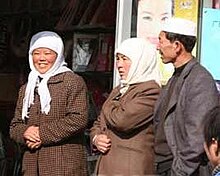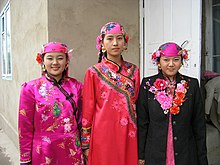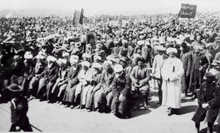
The Uyghurs, alternatively spelled Uighurs, Uygurs or Uigurs, are a Turkic ethnic group originating from and culturally affiliated with the general region of Central and East Asia. The Uyghurs are recognized as native to the Xinjiang Uyghur Autonomous Region in Northwest China. They are one of China's 55 officially recognized ethnic minorities. The Uyghurs are recognized by the Chinese government as a regional minority and the titular people of Xinjiang.

The China proper, Inner China (中國內地) or Eighteen Provinces inside the Pass (關內十八省) is a term used by some Western writers in reference to the traditional "core" regions of China.
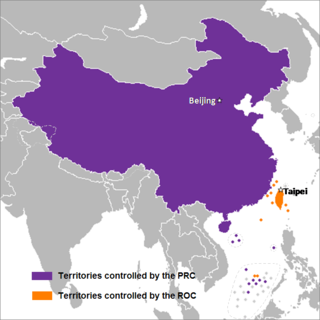
Chinese unification, also known as the Cross-Strait unification or Chinese reunification, is the potential unification of territories currently controlled, or claimed, by the People's Republic of China and the Republic of China ("Taiwan") under one political entity, possibly the formation of a political union between the two republics. Together with full Taiwan independence, unification is one of the main proposals to address questions on the political status of Taiwan, which is a central focus of Cross-Strait relations.
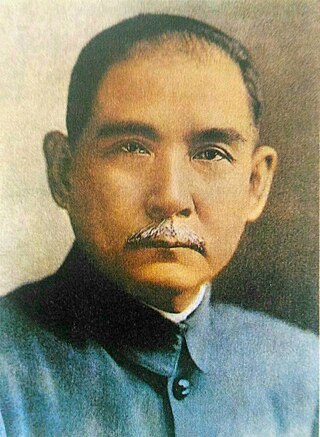
The Three Principles of the People is a political philosophy developed by Sun Yat-sen as part of a philosophy to improve China made during the Republican Era. The three principles are often translated into and summarized as nationalism, democracy, and the livelihood of the people. This philosophy has been claimed as the cornerstone of the nation's policy as carried by the Kuomintang (KMT); the principles also appear in the first line of the national anthem of the Republic of China.

The Hui people are an East Asian ethnoreligious group predominantly composed of Chinese-speaking adherents of Islam. They are distributed throughout China, mainly in the northwestern provinces and in the Zhongyuan region. According to the 2011 census, China is home to approximately 10.5 million Hui people. The 110,000 Dungan people of Kazakhstan and Kyrgyzstan are also considered part of the Hui ethnicity.
Ethnic minorities in China are the non-Han population in the People's Republic of China (PRC).
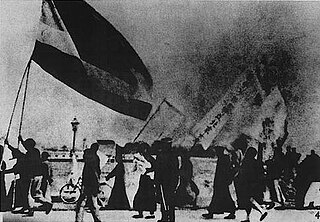
Chinese nationalism is a form of nationalism in which asserts that the Chinese people are a nation and promotes the cultural and national unity of all Chinese people. It is often equated with Han nationalism, although these two concepts are different. According to Sun Yat-sen's philosophy in the Three Principles of the People, Chinese nationalism should be a form of civic nationalism constructed on top of a united value, however this has not been fully recognized or applied in practice by successors.
Sinicization, sinofication, sinification, or sinonization is the process by which non-Chinese societies or groups are acculturated or assimilated into Chinese culture, particularly the language, societal norms, culture, and ethnic identity of the Han Chinese—the largest ethnic group of China.
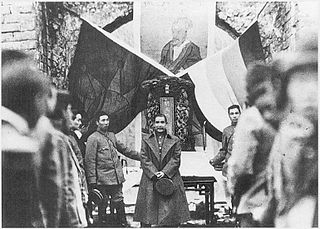
Han nationalism is a form of ethnic nationalism asserting ethnically Han people as the exclusive constituents of the Chinese nation. It is often in dialogue with other conceptions of Chinese nationalism, often mutually-exclusive or otherwise contradictory ones. Han people are the dominant ethnic group in both states claiming to represent the Chinese nation: the Republic of China and the People's Republic of China. Han people also constitute a sizable ethnic minority or plurality group in a number of other countries, such as Malaysia and Singapore. In the modern era, ethnicity's role in the Chinese nation continue to color conceptions of Chinese culture, geopolitics, and history.

East Turkestan is a loosely-defined geographical and historical region in the western provinces of the People's Republic of China, which varies in meaning by context and usage. The term was coined in the 19th century by Russian Turkologists, including Nikita Bichurin, who intended the name to replace the common Western term for the region, Chinese Turkestan, which referred to the Tarim Basin in the southwestern part of Xinjiang during the Qing dynasty. The medieval Persian toponym "Turkestan" and its derivatives were used by the local population as early as the 7th century. Historical manuscripts, dating back to the 7th and 9th century, found in the Turpan and Khotan regions, show that the name Turkestan was used to describe the region. The opening of the 11th century literary work Kutadgu Bilig by Kara-Khanid statesman Yusuf Khass Hajib also describes the region as Turkestan. Beginning in the 17th century, Altishahr, which means "Six Cities" in Uyghur, became the Uyghur name for the Tarim Basin. Uyghurs also called the Tarim Basin "Yettishar," which means "Seven Cities," and even "Sekkizshahr", which means "Eight Cities" in Uyghur. Chinese dynasties from the Han dynasty to the Tang dynasty had called an overlapping area the "Western Regions". The parts of this area conquered by the Manchu Qing Dynasty were termed "Xinjiang" from the 18th century on.

The Chinese people or simply Chinese, are people or ethnic groups identified with China, usually through ethnicity, nationality, citizenship, or other affiliation.

Islam has been practiced in China since the 7th century CE. Muslims are a minority group in China, representing 1.6 to 2 percent of the total population according to various estimates. Though Hui Muslims are the most numerous group, the greatest concentration of Muslims are in Xinjiang, which contains a significant Uyghur population. Lesser yet significant populations reside in the regions of Ningxia, Gansu and Qinghai. Of China's 55 officially recognized minority peoples, ten of these groups are predominantly Sunni Muslim.

The National Ethnic Affairs Commission is a cabinet-level executive department of the State Council of the People's Republic of China under the formal leadership of the United Front Work Department that is responsible for relations between the Chinese government and ethnic minorities in China. It supervises the implementation - and monitors the performance - of national and regional systems to manage ethnic minorities.

After the fall of the Qing dynasty following the Xinhai Revolution (1911), Sun Yat-sen, who led the new Republic of China (1912–1949), immediately proclaimed that the country belonged equally to the Han, Hui (Muslim), Meng (Mongol), and Tsang (Tibetan) peoples. When the People's Republic of China was established in 1949, Chinese Muslims suffered political repression along with all other religious groups in China, especially during the Cultural Revolution (1966–1976).
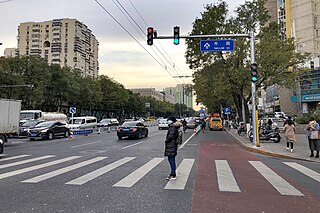
Niujie is a subdistrict in Xicheng District in southwest Beijing, China. The name "Niujie" can refer to the street Niujie or to the neighborhood Niujie. The subdistrict was previously in Xuanwu District before the district was merged into Xicheng District in 2010. As of 2020, its total population is 51,410.

The Concordia Association was a political party in Manchukuo. Established to promote the ideals of Pan-Asianism and the creation of a multi-ethnic nation-state and to create a structure which would gradually replace military rule over Manchukuo with civilian control, the party was unable to fulfill its promise, and was eventually subverted into an instrument of totalitarian state-control by the Japanese Kwantung Army.

Zhonghua minzu is a political term in modern Chinese nationalism related to the concepts of nation-building, ethnicity, and race in the Chinese nationality.
The Panthay Rebellion (1856–1873), also known as the Du Wenxiu Rebellion, was a rebellion of the Muslim Hui people and other ethnic groups against the Manchu-led Qing dynasty in southwestern Yunnan Province, as part of a wave of Hui-led multi-ethnic unrest.

Beijing has a large community of Hui people, totaling 249,223 people per the 2010 Chinese Census, or 2.35% of the city's total population. As of 2010, the Hui are the second largest minority in the city, behind the Manchu. Neighborhoods with high concentrations of Hui people, such as Niujie, exist throughout the city.
Uyghur nationalism is a nationalist movement which asserts that the Uyghur people, an ethnic minority in China, are a distinct nation. Uyghur nationalism promotes the cultural unity of the Uyghur people, either as an independent group or as a regional group within a larger Chinese nation.
